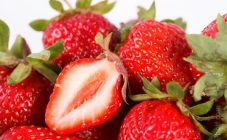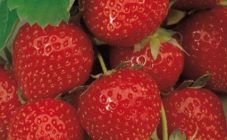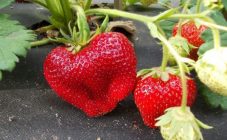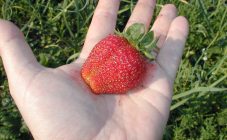Content:
Strawberry First Grader is a kind of garden strawberry, which appeared as a result of the selection of varieties Fairy and Torpedo. This hybrid is included in the State Register of Russia for the West Siberian region. This variety is specially bred for the harsh conditions of Siberia. We were engaged in the development of a hybrid A.D. Zabelina and N.P. Stolnikov.
Characteristics and description of strawberries First grader
The fruits are versatile in use. The weight of a large berry reaches 30 g, and of an average one - up to 10 g. The taste of the fruits is sweet with a slight sourness. The tasters rate it at 4 points out of 5 possible. In terms of ripening, strawberries are mid-late.
The bush grows straight with many leaves. Height reaches 30 cm. Antennae are medium, dark green. The flowers are cream-colored, of both sexes, rounded and wavy. Blooms in early July.
Strawberry grade First-grader - average in frost resistance, but resistant to pests and diseases.
Landing
Any type of soil is suitable for growing it. The main thing is that the site is located in the sun or in partial shade. The land for strawberries should be prepared in 2 months. Add humus and 70 g of complex fertilizer per 1 m².
The strawberry area should be ventilated and free. The bushes are planted at a distance of 25-30 cm from each other. You can plant strawberries throughout the season: in spring, in July, or a month before the first frost.
Further care
Watering the plant must be plentiful and regular, which should continue even after picking the berries. Irrigation is carried out at the rate of 1 bucket per 1 m². Water must penetrate 20 cm deep, since it is at this depth that the roots lie.
Fertilizers are applied at the end of May, when the fruits begin to form. To do this, take 20 g of monophosphate, dilute in 10 liters of water. This is enough for 5 bushes. Or 200 g of wood ash is diluted in 1 liter of hot water, then this mixture is diluted with another 10 liters of water, and then watered under the bushes by 1 liter.
Or here's another recipe: fresh cow dung is diluted with water and left to ferment for 2 weeks, stir every 3 days. The resulting slurry is poured under each bush. Or the chicken droppings are diluted 1:10 with water and immediately watered with strawberries.
Do not forget about loosening, which saturates the soil with oxygen. The procedure is contraindicated during flowering and berry formation.
Strawberries reproduce with tendrils. It will not work to breed strawberries with self-collected seeds, since plants from seeds will lose all their breeding characteristics.
Advantages and disadvantages of the variety
Gardeners note the following advantages of strawberries:
- universal use of fruits;
- ease of growing and care;
- yields in partial shade;
- resistant to pests and diseases;
- high taste.
There is only one drawback - this is average frost resistance, which is why it is worth covering with straw for the winter. But this is not a problem if grapes and roses are already growing on the site, which also take cover every year before frosts, that is, the gardener already has experience in this.
That's all about strawberries First-grader! So, observing the rules of planting and care, you can harvest the first first-class harvest in the first year.














